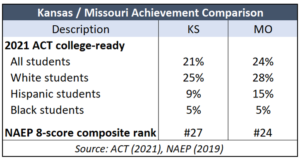[vc_row][vc_column][vc_column_text]Education officials contend schools are underfunded, but Kansas had the 11th-highest spending per student in 2020, adjusted for the cost of living in each state. Education officials also believe the states that spend the most have the best outcomes, yet achievement continues to decline in Kansas while spending shoots significantly higher. So predictably, school officials are trying to convince parents that they just don’t have enough money and deceiving them about achievement levels.
 New U.S. Census data shows Kansas spent $15,192 per student in 2020, but a dollar spent here buys a lot more than a dollar in New York and other states. According to the Missouri Economic Research and Information Center (MERIC), Kansas has the second-lowest cost of living at 86.5% of the national average, making spending $17,563 per student in comparison to other states.
New U.S. Census data shows Kansas spent $15,192 per student in 2020, but a dollar spent here buys a lot more than a dollar in New York and other states. According to the Missouri Economic Research and Information Center (MERIC), Kansas has the second-lowest cost of living at 86.5% of the national average, making spending $17,563 per student in comparison to other states.
State aid per student – so not including local or federal funding – adjusted for the cost of living is #4 in the nation, at $11,287. Kansas is also ranked #4 for debt per student, at $15,570.
By comparison, spending per student in Missouri is a lot less than in Kansas, coming in at $14,768 per student, but Missouri has higher achievement.
Missouri spends less, achieves more
Missouri graduates who took the 2021 ACT had higher college readiness than Kansas. Overall, 24% were college-ready compared to 21% for Kansas. Most of the primary cohorts also did better in Missouri: White students (28% vs. 25%), Hispanic students (15% vs. 9%), and Black students tied at 5%.
 Some of the difference can be attributed to higher ACT participation in Kansas; 79% of Kansas graduates took the ACT but only 63% in Missouri.
Some of the difference can be attributed to higher ACT participation in Kansas; 79% of Kansas graduates took the ACT but only 63% in Missouri.
But there is no such excuse on the National Assessment of Educational Progress (NAEP). Missouri did slightly better on the 8-score composite (fourth grade and eighth grade reading and math for low-income students and all other students); Missouri is ranked #24 and Kansas is ranked #27.
It’s important to focus on ACT and NAEP because they allow for comparisons across states, whereas state-based metrics are determined by the state and differ from one state to the next. NAEP has been called the “gold standard” and, when combined with the ACT results, produces the best apples-to-apples comparison of student achievement.
Education officials consciously deceive parents and legislators about student achievement, but the harsh reality is that Kansas is below average in a nation that doesn’t do all that well.
Kansas schools want more money
Many Kansas school districts are making budget cuts for the coming school year because they’ve lost students as a result of their COVID decisions and race/gender indoctrination, and they are finally feeling the financial impact. But rather than admit the truth, education officials are blaming the cuts on not having enough money.
Johnson County schools told KMBC-TV that the state isn’t funding special education as required by the constitution, but that’s not true; the constitution is silent on special education funding.
State law says 92% of special education spending that isn’t covered by federal aid is supposed to be reimbursed, but even that is misleading. The State Supreme Court accepted the Legislature’s funding proposal that included a $44 million increase in special education funding for FY 2019 and a $7.5 million increase each year thereafter. Those amounts have been exceeded, so schools are constitutionally funded as viewed by courts.
Also, legislators don’t really know how much schools are legitimately spending on special education because the numbers haven’t been audited. A 2019 audit found schools were not property recording at-risk spending as required in state law, resulting in spending being over-stated.
Benjamin Franklin wrote, “In this world, nothing can be said to be certain, except death and taxes.” We can add two more to the list in Kansas. Funding will never be high enough to satisfy education officials, and they won’t do anything about low achievement without legislative intervention.[/vc_column_text][/vc_column][/vc_row]




